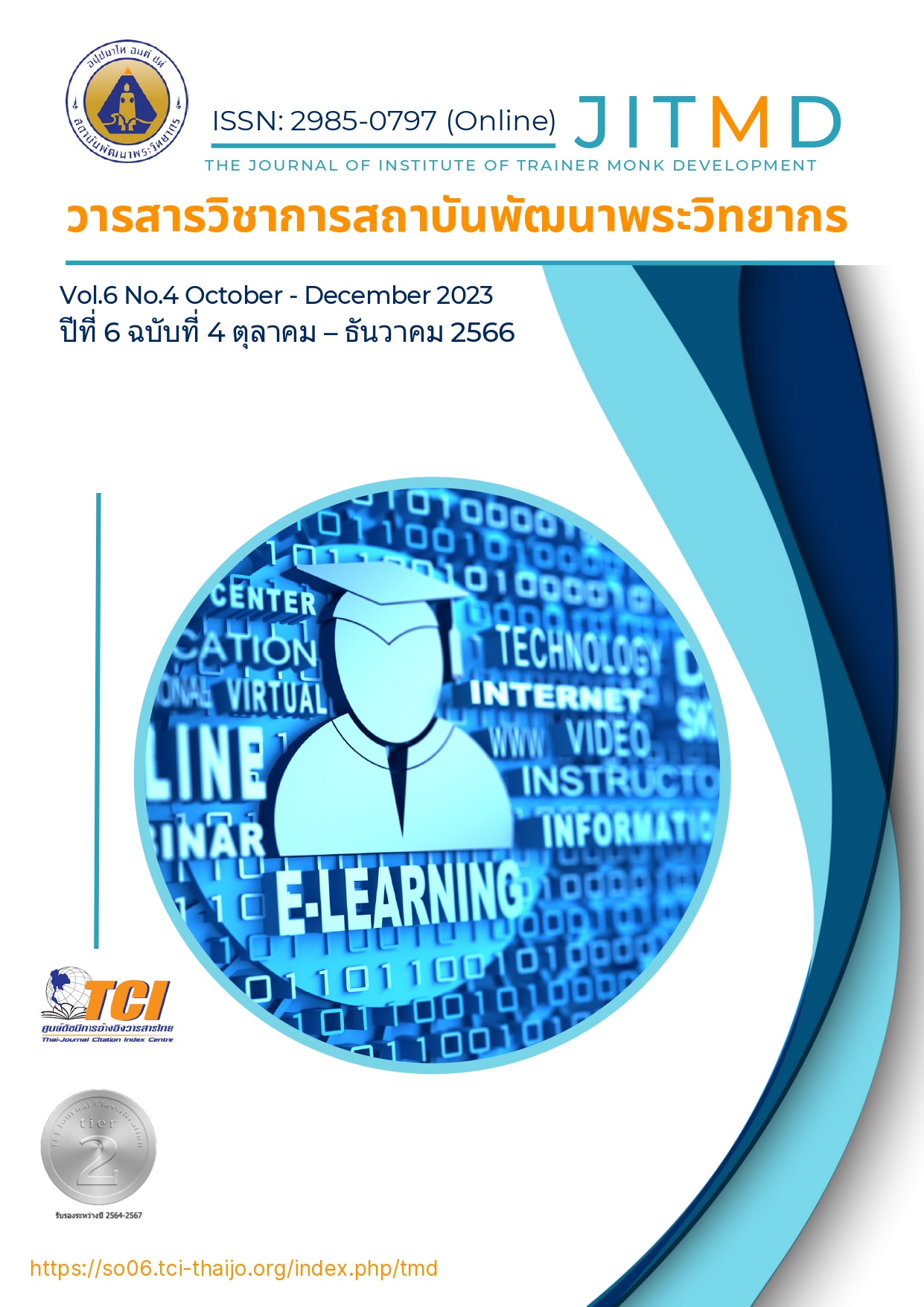The Development of Teaching Models That Promote to Five Minds for the Future for Students Educational Administration Branch in Mahamakut Buddhist University
Main Article Content
Abstract
The objectives of this thesis were: 1) Develop a teaching model that promotes the five minds, thinking for the future. for students Educational Administration, Mahamakut Buddhist university, and 2) to study the effectiveness of a teaching model that promotes the Five Minds Thinking for the Future developed. how to conduct research It is an experimental research study. The target group used were students in the field of educational administration Mahamakut Buddhist university, academic year 2022, 19 people. The research instrument was a questionnaire. Perform data analysis with basic statistics, and one-way ANOVA; repeated measures. The results of research were found that: 1. The developed teaching style consists of the principle of stimulating interest. proactive learning from practice crystallized teaching and reflection. The purpose of the pattern to develop learners to have a mind of science. spirit of respect ethical mind Synthesis mind and creative mind. The teaching steps of the teaching model (RIKCER Model) are 6 steps, namely route planning. Searching for information to select blending knowledge concept synthesis Ethical learning exchange and reflecting on the five minds, thinking for the future. As for the measurement and evaluation of the teaching style, it is the measurement and evaluation that occurs both during and after teaching according to the teaching style. The assessor consists of teachers. students and friends. 2. The effectiveness of the developed teaching model found that the target group of learners who learned by using the teaching model promoting 5 minds, thinking for the future. have an achievement score having a scientific mind having a spirit of respect morality mental ability of synthetic thinking and creativity higher than before There was a statistical significance at the .01 level in all aspects and satisfaction with the teaching style of 5 mind thinking for the future. at the highest level.
Article Details

This work is licensed under a Creative Commons Attribution-NonCommercial-NoDerivatives 4.0 International License.
บทความที่ได้รับการตีพิมพ์เป็นลิขสิทธิ์ของวารสารวิชาการสถาบันพัฒนาพระวิทยากร
ข้อความที่ปรากฎอยู่ในบทความที่ได้รับการตีพิมพ์ในวารสาร ถือเป็นความรับผิดชอบของผู้เขียนบทความ และข้อคิดเห็นนั้นไม่ถือว่าเป็นทัศนะและความรับผิดชอบของกองบรรณาธิการวารสารวิชาการสถาบันพัฒนาพระวิทยากร
References
ทัศนา แขมมณี. (2556). ศาสตร์การสอน: องค์ความรู้เพื่อการจัดกระบวนการเรียนรู้ที่มีประสิทธิภาพ.พิมพ์ครั้งที่ 17. กรุงเทพมหานคร: จุฬาลงกรณ์มหาวิทยาลัย.
นวลจันทร์ สมุทรสกุลเจริญ. (2552). การศึกษากระบวนการเรียนรู้ทางพระพุทธศาสนาเพื่อพัฒนาพหุปัญญาของผู้เรียนวิชาวิถีธรรม วิถีไทย : กรณีศึกษานักศึกษาระดับประกาศนียบัตร
วิชาชีพ (ปวช.) วิทยาลัยเทคนิคดอนเมือง. สถาบันวิจัยพุทธศาสตร์ มหาวิทยาลัยมหาจุฬาลงกรณราชวิทยาลัย.
ประเวศ วะสี. (2552). อุดมศึกษาคือหัวรถจักรทางปัญญาพาชาติออกจากวิกฤต. กรุงเทพมหานคร: ทีคิวพี.
มหาวิทยาลัยมหามกุฏราชวิทยาลัย. (2556). แผนกลยุทธ์มหาวิทยาลัยมหามกุฏราชวิทยาลัยระยะ 10 ปี (พ.ศ. 2556 – 2565).
มหาวิทยาลัยมหามกุฏราชวิทยาลัย. (2560). หลักสูตรศึกษาศาสตรมหาบัณฑิต สาขาวิชาการบริหารการศึกษา (หลักสูตรปรับปรุง พ.ศ. 2560). นครปฐม: มปท..
มหาวิทยาลัยมหามกุฏราชวิทยาลัย. (2562). SAR. 2562. บทสรุปผู้บริหาร.
สำนักงานเลขาธิการสภาการศึกษา. (2556). รูปแบบการบริหารจัดการสถาบันอุดมศึกษาแนวใหม่. กรุงเทพมหานคร: สำนักโยบายและแผนการศึกษา.
มหาวิทยาลัยมหามกุฏราชวิทยาลัย. 2560). แผนการศึกษาแห่งชาติ พ.ศ.2560 - 2579. กรุงเทพมหานคร: พริกหวานกราฟฟิค.
ไสว ฟักขาว. (2557). การพัฒนารูปแบบการเรียนการสอนที่เสริมสร้างจิต 5 ลักษณะเพื่ออนาคตสำหรับนักศึกษา ระดับปริญญาตรี คณะศึกษาศาสตร์ มหาวิทยาลัยราชภัฏจันทรเกษม.
Arends, R. I. (2001). Learning to teach (5th ed.). Singapore: McGraw-Hill.
Clement, R. (2006). Motivation, self- confdence, and group cohesion in the foreign language classroom. Language Learning, 44, 417-488.
Gardner, H. (2006). “Five minds for the future.” Boston: Harvard Business School. 6(3), 369.
Joyce, B., & Weil, M., & Calhoun, E. (2004). Models of teaching (7 th ed.). Boston: Pearson Education.
Wong, S. L. (2005). Language learning strategies and language self-efficacy: Investigating Their relationship in Malaysia. RELC Journal, 36(3), 245-269.


